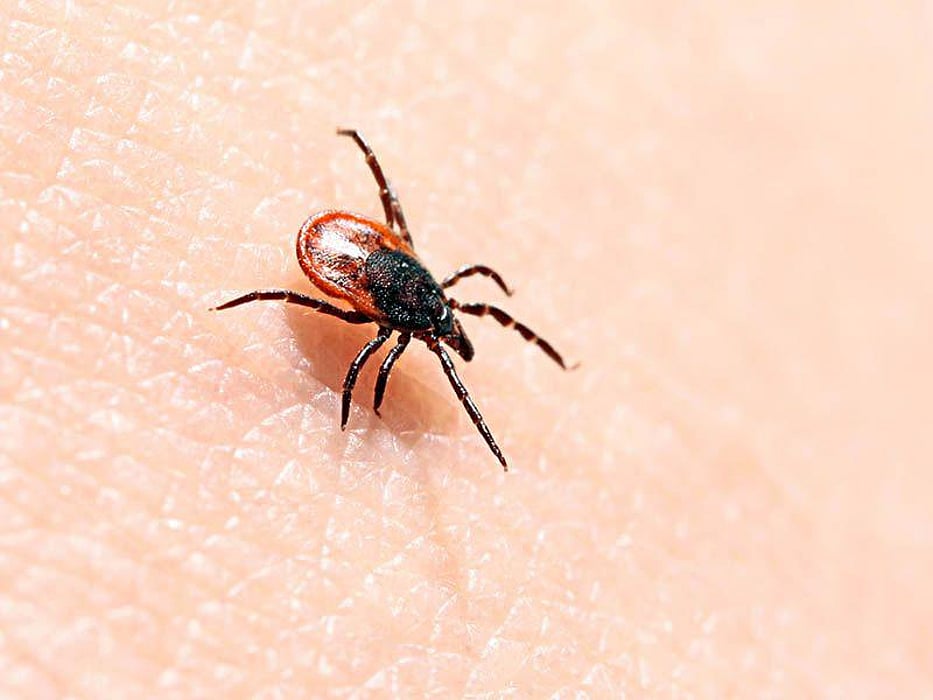Tick Bites

What should I do if my child is bitten by a tick?
First, remove the tick. Forget any advice you've heard about applying petroleum jelly, fingernail polish, or a hot match to the end of the tick. Those home remedies almost never work. Instead of forcing the tick to withdraw, they're likely to kill the tick while it's embedded in the skin, which increases the risk of infection.
Although it's not foolproof, the best way to remove a tick is to pull it gently out with tweezers. Grasp the bug as close to where it's connected as you can, and slowly lift it away from the skin. Don't twist or jerk the tweezers or you may break off the tick's body, leaving the head behind, which can lead to infection. Wash the bite area and your hands with soap and water after removing the bug. If you live in an area where tick-borne diseases like Lyme disease or Rocky Mountain spotted fever occur, save the tick by putting it in a small container filled with rubbing alcohol. That way your child's doctor can test it if trouble arises. Otherwise, dispose of it in the toilet.
Be sure to check the rest of your child's body to see if there are other ticks. Look carefully over your child's scalp, armpits, and groin area - some of ticks' favorite hiding places.
What if I don't have tweezers handy?
You can scrape off deer ticks, which are no bigger than the head of a pin, with a knife blade or the edge of a credit card. For wood ticks (sometimes called dog ticks), which can be up to half an inch long, use your fingers. Again, try to grasp the tick as close to the skin as possible and pull upward in a steady, gentle motion until the tick releases its grip. As soon as you can, wash the area with soap and water - or at least a moist towelette.
What if I don't remove all of it?
If part of the tick remains buried, try to get the rest out by using a needle boiled in water for five minutes, the way you would remove a wood splinter. Afterward, carefully wash the area with soap and water. If you can't remove the tick completely, call your child's doctor.
Should I worry about Lyme disease?
Ticks can carry a variety of germs -- including microbes that cause Lyme disease, Rocky Mountain spotted fever, and other diseases such as ehrlichiosis and tularemia. That's why it's important to remove the tick and clean the area as soon as you discover the problem. Afterward, keep an eye on your child. If a rash or fever develops during the following week, call your doctor. Fortunately, tick-borne illnesses are uncommon, and when detected early, they can be treated effectively with antibiotics.
Shouldn't the doctor prescribe antibiotics immediately?
No. Many parents are so worried about Lyme disease that they want their kids to take antibiotics just in case the tick is infected. Prescribing antibiotics this way is not recommended because there is no evidence that it prevents the disease. And the overuse of antibiotics poses its own dangers. Germs can become resistant to the drugs, which has become an increasing problem.
How can I protect my children from ticks?
The most reliable way to avoid ticks is to stay away from areas where they reside, which includes woods and fields. That's not always possible, of course. The second-best defense is to encourage your kids to wear long pants and long-sleeved shirts, and to tuck the ends of their pants into their socks; apply an insect repellent to socks and shoes. Choose a repellent that contains DEET, and be sure to use it safely. Do not apply repellent to your children's faces or hands or to cuts and scrapes. Wash it off promptly once you get home.
Wearing light-colored clothing can make it easier to spot ticks. If you go hiking with the family, check for ticks from time to time. At the end of the day, examine everyone's skin carefully. Taking a shower will remove ticks that haven't become firmly attached.
If you bring the family dog along, check him for ticks, too -- especially around the head and neck. Pets can pass ticks along to the rest of the family.
References
Robert H. Pantell M.D., James F. Fries M.D., Donald M. Vickery M.D., Taking Care of Your Child: A Parent's Illustrated Guide to Complete Medical Care. Perseus Books Publishing, L.L.C.
How to Remove a Tick. American Family Physician.
Kidshealth.org. Tick Removal: A Step-by-Step Guide. http://kidshealth.org/parent/general/body/tick_removal.html
Related Posts
Availability of CVD Meds Varies by Low-Cost Generic Program
WEDNESDAY, Sept. 6, 2023 (HealthDay News) -- For six cardiovascular diseases...
Could Depression Make Dry Eye Worse?
MONDAY, March 14, 2022 (HealthDay News) -- When people have both chronic dry eye...
US to Allow Medicaid to Pay for Drug Treatment in Prisons
WEDNESDAY, Feb. 22, 2023 (HealthDay News) – Soon, the federal government will...
Medicaid Expansion Tied to Greater Use of Cancer-Related Palliative Care
MONDAY, July 10, 2023 (HealthDay News) -- Medicaid expansion is associated with...
